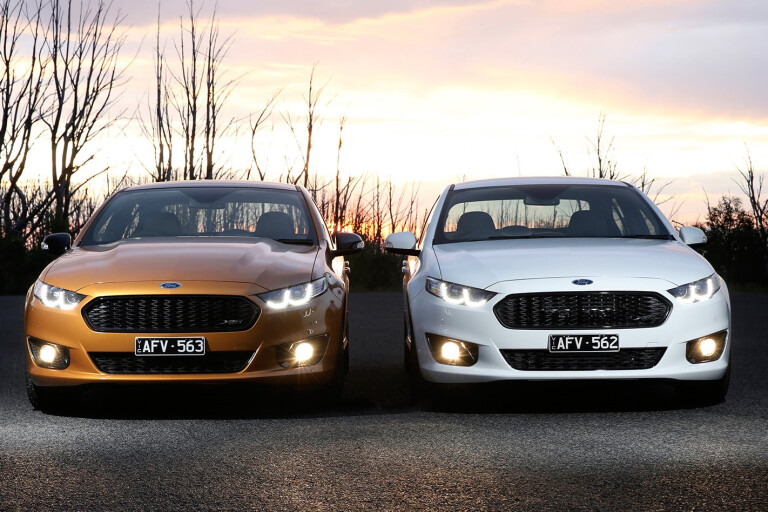
It was inevitable there would be a final Falcon of some kind. Not even the most cold-hearted bean counter could countenance closing the book on 56 years of tradition and heritage without a celebratory farewell model.
As it turns out, there are two, the XR8 and XR6 Sprint, reviving an iconic Falcon nameplate first used on the US version in 1963 before appearing locally on the ED XR8 30 years later.
Ford confirmed the existence of the Sprints just prior to Christmas 2015, however MOTOR first broke news of the farewell Falcons in our July 2015 issue. Once confirmed, the only remaining question was also the most important one: what form would they take? After all, Falcon sales have slowed to a relative trickle – just 5938 were sold in 2015 – so any significant investment was going to be hard to justify.
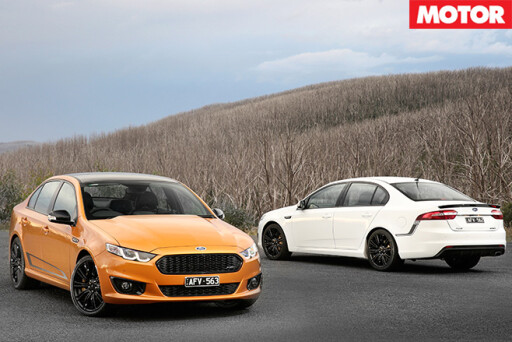 The smart money was a badge and styling exercise for the 335kW/570Nm XR8, while the 310kW/565Nm FPV F6 engine would be dusted off to say goodbye to the Aussie-built turbo six. Happily, the smart money was wrong, as the Sprint program is arguably the most comprehensive re-engineering of the Falcon platform since FPV’s introduction of the Miami 5.0-litre supercharged V8 in late-2010.
The smart money was a badge and styling exercise for the 335kW/570Nm XR8, while the 310kW/565Nm FPV F6 engine would be dusted off to say goodbye to the Aussie-built turbo six. Happily, the smart money was wrong, as the Sprint program is arguably the most comprehensive re-engineering of the Falcon platform since FPV’s introduction of the Miami 5.0-litre supercharged V8 in late-2010.
Regular consumers may be abandoning large cars in droves, but thankfully there are still plenty of enthusiasts out there who want a powerful, rear-drive sedan, and this made it easier for E8 (Falcon and Territory) Chief Program Engineer David Burn and his team to create a strong business case for a fitting Falcon farewell.
“When people look at large cars,” says Burn, “they say it’s a shrinking segment [but] if you look at who’s buying large cars, the performance car portion of the segment, both ourselves and Holden, is remarkably stable.” A perfect example is Ford having to double XR8 production due to unexpectedly high demand, however it turns out that the Sprint wheels were in motion prior to the XR8 appearing.
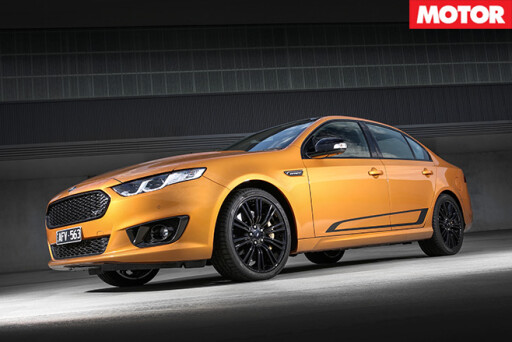 According to Burn, “If we rewind to the middle of 2014 myself, (Program Manager) Justin Capicchiano and Nick Eterovic, our styling guru, were having a look at FG X and thought ‘we’ve got to put out an XR’, something unexpected to celebrate Falcon and not do a parts-bin selection of the best bits.”
According to Burn, “If we rewind to the middle of 2014 myself, (Program Manager) Justin Capicchiano and Nick Eterovic, our styling guru, were having a look at FG X and thought ‘we’ve got to put out an XR’, something unexpected to celebrate Falcon and not do a parts-bin selection of the best bits.”
With the approval of the money men secured – “you don’t do a program on hopes and dreams,” says Capicchiano – the first two problems to be tackled were what’s it going to look like, and how much power will it have? “We had a fair bit of discussion about how the car should look,” says Burn.
“On the one extreme we have the lairy V8 Supercars appearance; on the other end you have to look at what customers are doing to our cars, particularly Turbos, where they make it much more of a sleeper-type car. We discussed it for a long time and started to zero in on the right answer, which is trying to make it subtle, make it stealth.”
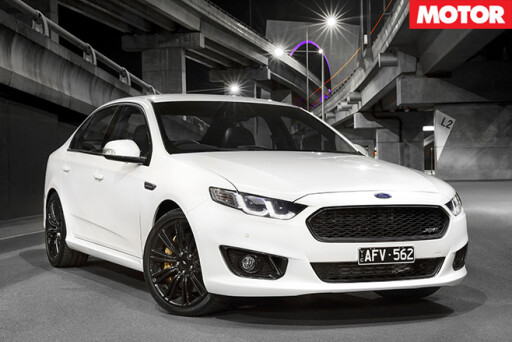 To achieve this ‘stealth’ look on the XR6 there are new black front fog-lamp surrounds, black headlamp bezels, body-coloured wing mirrors and deck-lid applique, black 19-inch wheels and, most noticeably, a subtle black rear lip spoiler, while the XR8 adds a black roof and wing mirrors.
To achieve this ‘stealth’ look on the XR6 there are new black front fog-lamp surrounds, black headlamp bezels, body-coloured wing mirrors and deck-lid applique, black 19-inch wheels and, most noticeably, a subtle black rear lip spoiler, while the XR8 adds a black roof and wing mirrors.
The overall look is much sleeker than we became accustomed to from FPV – more GT E than GT-P – and the smaller rear spoiler actually improves the car’s aero balance; the GT’s big rear wing produced more downforce than the front could match, which led to the nose lifting at speed.
And speed is something the new Sprints are very good at thanks to the powerhouses under their respective bonnets. On paper there seems little to shout about – with 345kW/575Nm, the XR8 Sprint offers only 10kW/5Nm more than a regular XR8, while the 325kW/576Nm XR6 Sprint improves on the old F6 by only 15kW/11Nm, however the amount of detail changes, particularly in the case of the Turbo, offer a swift rebuke to anyone who attributes the increases to a quick ECU flash.
 The XR8’s 5.0-litre supercharged Miami V8 has changed least, simply by virtue of its being the more developed package, however it incorporates a number of improvements introduced with the 351kW/570Nm GT F. Not, however, its power figure. Why not? “We didn’t want to put the 351 calibration into an XR8 and do something that was disingenuous to our GT F customers,” explains Burn.
The XR8’s 5.0-litre supercharged Miami V8 has changed least, simply by virtue of its being the more developed package, however it incorporates a number of improvements introduced with the 351kW/570Nm GT F. Not, however, its power figure. Why not? “We didn’t want to put the 351 calibration into an XR8 and do something that was disingenuous to our GT F customers,” explains Burn.
“That was a day one discussion,” agrees Capicchiano. “Three-fifty-one was a number that was symbolic to the GT nameplate; the power figure was sacrosanct to that car.” With the power ceiling set at 345kW, focus instead turned to improving drivability, the Sprint incorporating the GT F’s ‘twin pedal map’ which works in conjunction with Bosch’s ESP 9.0 system to smooth the power delivery.
While the regular XR8 also has the latest ESP system, the older 335kW tune isn’t optimised to work with it, whereas the GT F and the Sprint are almost able to ‘predict’ how much power the chassis is capable of using at any given point in time and subtly trim the driver’s throttle inputs to give the desired effect. If that all sounds a bit nanny state, fear not, we’ve no doubt with DSC deactivated both cars will melt their rear tyres in time-honoured Aussie tradition.
 Producing 576Nm, the XR6 Sprint’s 4.0-litre turbocharged inline-six is the torquiest Australian engine ever built by a solitary newton metre over the XR8, however in ‘transient overboost’ mode both cars share the honour with a whopping 650Nm.
Producing 576Nm, the XR6 Sprint’s 4.0-litre turbocharged inline-six is the torquiest Australian engine ever built by a solitary newton metre over the XR8, however in ‘transient overboost’ mode both cars share the honour with a whopping 650Nm.
The 10-second overboost limit means Ford can’t officially quote the cars’ maximum figures of 370kW/650Nm (XR6) and 400kW/650Nm (XR8), however Capicchiano is adamant that “on a normal day, you’ll be in overboost all the time”.
As the 10-second time period resets on every gear change, unless you’ve just completed 10 hot laps of a racetrack the Sprints will produce full whack all the way from rest to their limited 230km/h top speeds.
 Where the two engines differ is the way they produce the grunt. The Miami’s crank-driven supercharger means power builds and builds all the way to the 6250rpm cutout, whereas the Turbo comes on boost strong early and produces peak torque from 2500rpm all the way to cutout.
Where the two engines differ is the way they produce the grunt. The Miami’s crank-driven supercharger means power builds and builds all the way to the 6250rpm cutout, whereas the Turbo comes on boost strong early and produces peak torque from 2500rpm all the way to cutout.
It’s this enormous plateau that will make the XR6 Sprint the fastest six-cylinder Falcon ever. Its outright numbers might not be much higher than those of the FPV F6, but the Sprint engine is a very different beast – “the best in-line six we’ve ever done” according to Capicchiano. “Everyone thought 310 [kilowatts],” says Burn, before Capicchiano interjects with “from the start we said ‘nup’, we can do something different”.
While the engine itself is more or less bulletproof, its ultimate potential is limited by the ZF six-speed auto’s 650Nm torque limit, so the challenge became sustaining that maximum for as long as possible.
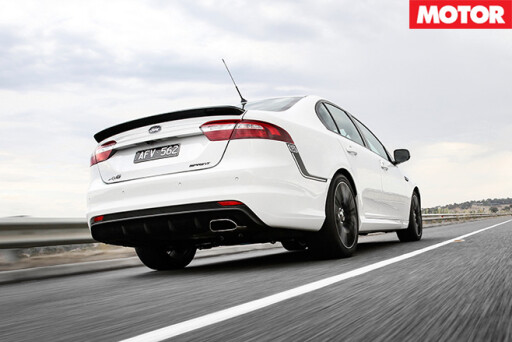 With increasing throttle response a key focus, XR6 Turbo pistons were chosen over F6 items for their lighter weight and ability to run more compression, though it quickly became clear that airflow would need to improve to control piston temperatures. “With a forced induction motor,” says Burn, “the single biggest thing you’ve got to look after is your piston temperatures – if you melt pistons it gets ugly real quick.”
With increasing throttle response a key focus, XR6 Turbo pistons were chosen over F6 items for their lighter weight and ability to run more compression, though it quickly became clear that airflow would need to improve to control piston temperatures. “With a forced induction motor,” says Burn, “the single biggest thing you’ve got to look after is your piston temperatures – if you melt pistons it gets ugly real quick.”
The fix was a new turbo-to-cat exhaust and swish new carbonfibre intake system designed and produced by local outfits Premcar and Quickstep Automotive respectively. It’s very odd lifting a Falcon bonnet and seeing that familiar black weave, but its looks aren’t as important as the 35 per cent improvement in air flow. To support the required outputs the F6 toy chest was raided and the turbo, injectors, fuel rail, intercooler, oil and transmission cooler all pilfered.
According to Capicchiano the result is “the most efficient pump in the shed; even at the power level we’re at we’re actually running less piston temp than an F6 [or] XR6 Turbo. We’re making more boost for a lot longer period of time in the mid-range – at 3000rpm it’s making 3psi more than F6 was – and there’s a big wedge more power from 4000-6000rpm.”
 And whereas the F6 reduced torque to protect the driveline in first and then held that same level through every gear, the Sprint has individual torque maps in each gear to deliver more and more twist as each successive gear is selected, the shifts themselves now crisper thanks to a new gearbox calibration from ZF.
And whereas the F6 reduced torque to protect the driveline in first and then held that same level through every gear, the Sprint has individual torque maps in each gear to deliver more and more twist as each successive gear is selected, the shifts themselves now crisper thanks to a new gearbox calibration from ZF.
Of course, in recent years power has never been a fast Falcon problem. As Capicchiano says, “the restriction was never the amount of power; it was everything else around it.” Both Sprints have launch control, however the different power delivery of each engine means each has its own system. However, the single biggest factor transforming the Falcon’s power-down capabilities is the fitment of Pirelli P Zero tyres, replacing the previous Dunlop SP Sport Maxx.
At the mention of the new rubber, both Burn and Capicchiano get visibly excited. “We love this part of the car,” says Capicchiano, “We’ve done everything around the tyres.” “When we did GT F the tyres were a massive limiting factor in getting the car off the line quickly,” explains Burn. “The Dunlops were great, but not suited to that high level of instantaneous grip; to get more grip into this car, the first thing on the list was some new boots.”
 In what must surely rate as the best day anyone’s ever had at work, dozens of sets of tyres were driven to destruction in an exhaustive tyre comparison with the Pirellis the victor. “It wasn’t a question of dollars,” says Burn. “We tested more expensive tyres and less expensive tyres; [the Pirellis] were the best.”
In what must surely rate as the best day anyone’s ever had at work, dozens of sets of tyres were driven to destruction in an exhaustive tyre comparison with the Pirellis the victor. “It wasn’t a question of dollars,” says Burn. “We tested more expensive tyres and less expensive tyres; [the Pirellis] were the best.”
The Sprints wear 245/35 fronts and 265/35 rears; while the latter are technically narrower than the Dunlops on the regular XR8, the actual contact patch is within half a millimetre.
Though it sounds easy, switching rubber necessitated 18 months of certification work as well as a comprehensive suspension redesign. “You can’t just put a tyre on the car and expect it to work,” explains Burn. “It significantly changes the way the car rides and handles [and] we ended up doing a complete ground-up suspension redesign.” As with the engines, the benefit of recent development meant the XR8 required less work, however there were a number of areas the team wanted to improve.
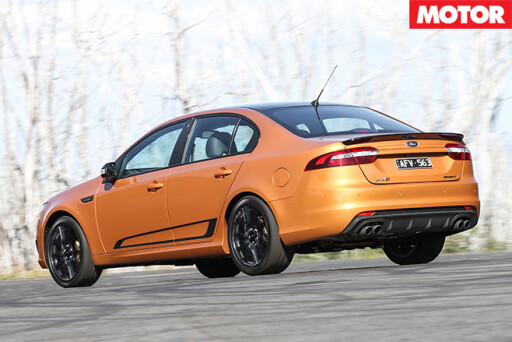 “For this car we didn’t want to go as hardcore as R-Spec,” says Burn. “There were some ride issues on patchy surfaces, [but] the Turbo was too soft for where we wanted to go. On past Falcons there’s always been a conscious effort to get a rolling plushness and that’s been at the expense of body control, so what we ended up doing is we came back a little on R-Spec spring rates but up a long way on the Turbo and we’re about 50 per cent higher in rebound damping. The end result is better balance and tauter body control.”
“For this car we didn’t want to go as hardcore as R-Spec,” says Burn. “There were some ride issues on patchy surfaces, [but] the Turbo was too soft for where we wanted to go. On past Falcons there’s always been a conscious effort to get a rolling plushness and that’s been at the expense of body control, so what we ended up doing is we came back a little on R-Spec spring rates but up a long way on the Turbo and we’re about 50 per cent higher in rebound damping. The end result is better balance and tauter body control.”
At this point Burn drops the bombshell: “and it does not understeer.” Pardon? Anyone who has driven an XR8 on track will be familiar with the sensation of sailing past apexes as that massive 5.0-litre supercharged V8 drags the nose wide and it turns out Burn, an experienced circuit and rally driver, agrees: “One of the big things I dislike about the V8s is it’s really hard to get the thing to tuck mid-corner; I kid you not, this car will pivot on its front axle mid-corner.” Capicchiano is equally effusive: “The first time we drove the XR8, it was like a friggin’ revelation.”
Fair enough, you’d expect the blokes responsible for building them to be singing the cars’ praises, but for them to speak with such confidence while acknowledging the shortcomings of previous models gives us hope that for the first time in a long time Ford’s hi-po Falcons will have the dynamic prowess to harness the rampaging horses under the bonnet.

A surprising amount of modification has taken place, and surprising pretty accurately describes the Sprint program. Few expected so much development and investment to be allocated to what will be very low-volume models; just 1400 Sprints will be built in total – 850 XR8s and 550 XR6s – with 150 off to our Kiwi cousins (in a 100:50 XR8:XR6 split).
Just how successful Ford has been at translating all this effort into a rewarding driving experience you can read over the page, however at least it’s made an effort. After years of being criticised for letting Falcon wither on the vine it’s given the last Falcons the best possible chance of also being the best.

COMMENTS